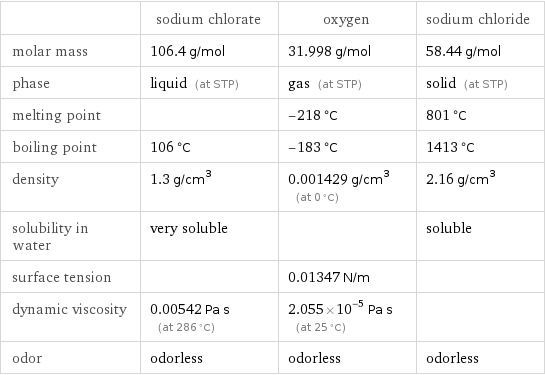Input interpretation

NaClO_3 (sodium chlorate) ⟶ O_2 (oxygen) + NaCl (sodium chloride)
Balanced equation

Balance the chemical equation algebraically: NaClO_3 ⟶ O_2 + NaCl Add stoichiometric coefficients, c_i, to the reactants and products: c_1 NaClO_3 ⟶ c_2 O_2 + c_3 NaCl Set the number of atoms in the reactants equal to the number of atoms in the products for Cl, Na and O: Cl: | c_1 = c_3 Na: | c_1 = c_3 O: | 3 c_1 = 2 c_2 Since the coefficients are relative quantities and underdetermined, choose a coefficient to set arbitrarily. To keep the coefficients small, the arbitrary value is ordinarily one. For instance, set c_1 = 1 and solve the system of equations for the remaining coefficients: c_1 = 1 c_2 = 3/2 c_3 = 1 Multiply by the least common denominator, 2, to eliminate fractional coefficients: c_1 = 2 c_2 = 3 c_3 = 2 Substitute the coefficients into the chemical reaction to obtain the balanced equation: Answer: | | 2 NaClO_3 ⟶ 3 O_2 + 2 NaCl
Structures

⟶ +
Names

sodium chlorate ⟶ oxygen + sodium chloride
Equilibrium constant
![K_c = ([O2]^3 [NaCl]^2)/[NaClO3]^2](../image_source/e2f5f9139b35ec24d8e4c95385ec2c8a.png)
K_c = ([O2]^3 [NaCl]^2)/[NaClO3]^2
Rate of reaction
![rate = -1/2 (Δ[NaClO3])/(Δt) = 1/3 (Δ[O2])/(Δt) = 1/2 (Δ[NaCl])/(Δt) (assuming constant volume and no accumulation of intermediates or side products)](../image_source/c1f6ce22a060eda006877ec44693c8fa.png)
rate = -1/2 (Δ[NaClO3])/(Δt) = 1/3 (Δ[O2])/(Δt) = 1/2 (Δ[NaCl])/(Δt) (assuming constant volume and no accumulation of intermediates or side products)
Chemical names and formulas

| sodium chlorate | oxygen | sodium chloride formula | NaClO_3 | O_2 | NaCl Hill formula | ClNaO_3 | O_2 | ClNa name | sodium chlorate | oxygen | sodium chloride IUPAC name | sodium chlorate | molecular oxygen | sodium chloride
Substance properties

| sodium chlorate | oxygen | sodium chloride molar mass | 106.4 g/mol | 31.998 g/mol | 58.44 g/mol phase | liquid (at STP) | gas (at STP) | solid (at STP) melting point | | -218 °C | 801 °C boiling point | 106 °C | -183 °C | 1413 °C density | 1.3 g/cm^3 | 0.001429 g/cm^3 (at 0 °C) | 2.16 g/cm^3 solubility in water | very soluble | | soluble surface tension | | 0.01347 N/m | dynamic viscosity | 0.00542 Pa s (at 286 °C) | 2.055×10^-5 Pa s (at 25 °C) | odor | odorless | odorless | odorless
Units
